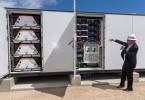All their eggs in one basket
The threat of lawsuits over coal-fired power plants may have played a role. But no one who’s watched Nevada politics would discount the behind-the-scenes power of U.S. Senate Majority Leader Harry Reid, who seems curiously enamored with any number of subsidy-dependent wind and solar energy installations in our area.
Sen. Reid recently addressed the Nevada Legislature, asking lawmakers to fix a “loophole” in state law that allows electricity monopoly NV Energy to meet the state’s who-cares-what-it-costs renewable energy mandate by buying hydroelectric power from Utah and, as some of his green champions put it, “occasionally handing out new light bulbs at Home Depot.”
Sen. Reid wants the utility to use more wind, solar and geothermal power. Since NV Energy is allowed by regulators to charge rates that add a profit (about 10 percent) on top of their costs, they have no strong incentive to argue.
So NV Energy officials went before the Legislature this month to seek legislation embracing their latest emission reduction and capacity replacement plan, called NVision.
Essentially, they plan to stop burning coal. Instead, the utility would get virtually all its power from natural gas and renewables. The utility would add (figures revised by the utility as late as Friday afternoon) 750 megawatts of natural gas generating capacity and 150 megawatts of new in-state capacity from politically correct sources — wind, solar, geothermal — which taxpayers already subsidize in numerous ways.
First, the utility would retire three of the four units at the Reid Gardner Generating Station, 50 miles northeast of Las Vegas, shuttering the plant entirely by 2017, six years early.
NV Energy then wants to stop drawing power from the Navajo coal-burning plant in northern Arizona by 2019 instead of 2026. The utility’s only other coal-burning plants, near Battle Mountain, are scheduled for retirement by 2025.
The cost of this all-eggs-in-one-basket plan? NV Energy says rate increases of 1.65 percent a year for 20 years, on average, will be needed to pay for the conversion.
While that number would compound to a 38.7 percent rate hike over 20 years, NV Energy argues its rates would go up by 34.4 percent over 20 years, anyway — thanks in large part to the costs associated with meeting continually more rigorous standards for coal, imposed precisely to produce this result.
A difference of only about 4 percent over 20 years doesn’t sound like much. But are these numbers credible, when power from “renewable” sources often cost twice as much as fossil fuels? Somebody needs to check the underlying cost assumptions, especially since the main purpose of taking this to the Legislature — providing only a week for deliberation, or only one afternoon, in the case of Friday’s late amendment — was apparently to change the standard under which the PUC will decide whether the plan is “prudent,” amending the previous provision which gave high priority to “low cost.”
The other big risk here, of course, is the extent to which this plans puts all of Nevada’s energy eggs in one basket.
Natural gas prices are now attractively low. It’s a domestic source of energy, unlikely to be interrupted by foreign potentates. But it’s still a single source. Can anyone really accurately predict what it will cost in 20 years? Or how much cheaper coal might remain?
And to say that concern is mitigated by building more wind and solar farms is a bit disingenuous. First, the utility as of Friday dropped its commitment to new “renewables” (perhaps wisely) from 600 to 150 megawatts. Second, these are relatively new technologies. Britain recently discovered the generators in its windfarms are aging — and thus producing less power, year-by-year — at twice the rate originally estimated. Environmental lawsuits have forced many California wind turbines to be idled during bird migration seasons; whole uneconomic wind farms stand idle in Hawaii.
Wind turbines also kill bats — millions of them — and can’t deliver power without new transmission lines, each of which will generate its own rash of environmental lawsuits.
Not only that, with the possible exception of molten sodium solar — which stores some heat to provide capacity after sunset — most “renewable” energy sources are intermittent, so every wind or solar farm needs equivalent backup capacity in quick-fired generators, powered by ... natural gas.
Legislators, anxious to prove how “green” they are, are rushing to embrace this plan without a lot of deliberation — or even reading time. The PUC, in its turn, is likely to figure, “Gee, if the Legislature already OK’d this, how can we challenge its prudence?” — especially with the definition of “prudence” now changed by law to dilute concerns over cost.
Thus we see the risk of turning over power generation to a government-regulated monopoly, a system highly susceptible to political pressure, with politics now apparently removing any requirement that the PUC require lowest possible cost and a diverse generating portfolio.
Hotels, restaurants, and casinos have to pass on their energy costs to customers, in an ever more competitive world. If we unnecessarily drive up the cost of doing business in Nevada, who’s to say more and more tourists — especially Asian tourists — won’t decide they can get a better deal at casinos and hotels closer to home? That wouldn’t be “prudent.”























